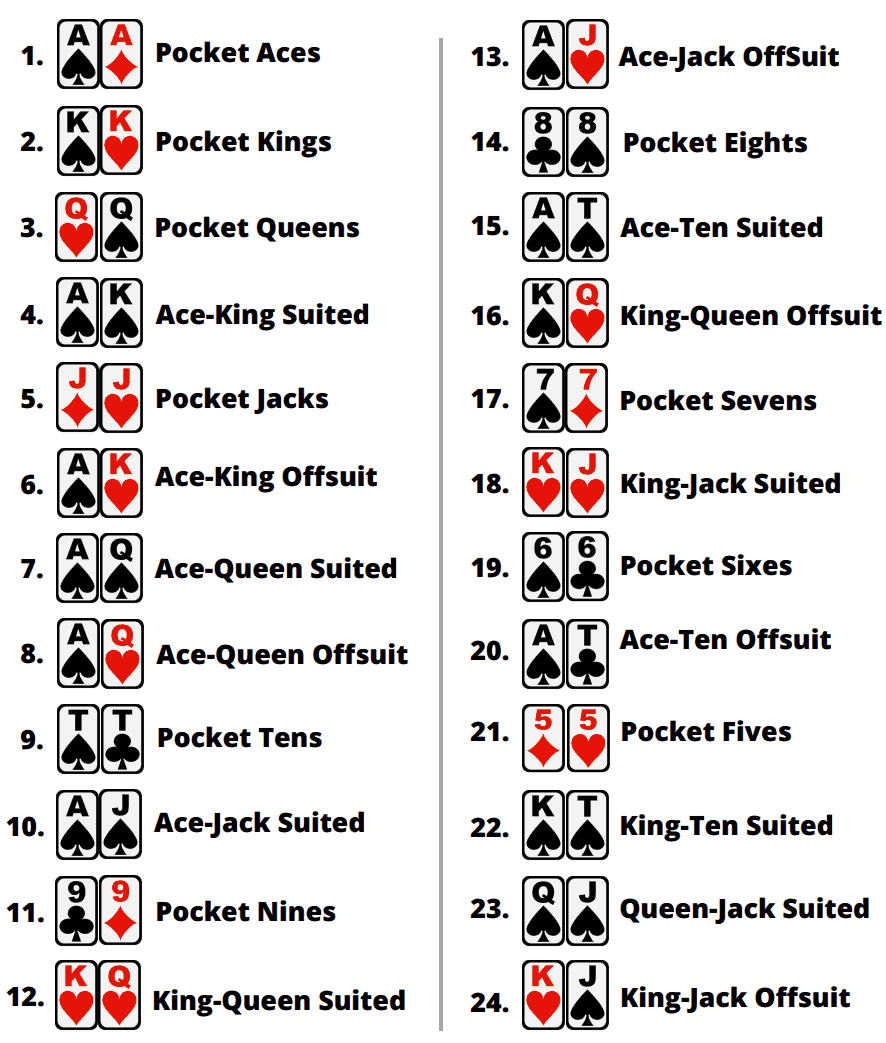Texas Hold’em Rules – an Idiot’s guide
Every player is dealt two cards, known as ‘hole cards’ and each player then decides whether to bet or fold their hand, depending on whether they think they will win the hand.
The dealer then draws three cards and puts them face-up on the table. This is called the ‘flop’. Players who didn’t fold previously again decide whether to check, bet, raise or fold.
Once the betting is complete, the dealer then draws another card and places it face up on the table. This is called the ‘turn’. Players who didn’t fold previously again decide whether to bet, raise or fold.
Finally, the dealer draws another card and places it face up on the table. This is called the ‘river’. The remaining players then decide whether to bet, raise or fold. If two or more players bet the same amount all cards can be revealed and the best poker hand wins the pot. It’s that simple!
BUT… after you’ve been playing for a while you will realize that there are also a number of subtleties, strategies and tactics that you can learn how to use to your advantage. Even the most experienced players keep learning
There are some other simple things you need to know before you get started.
How do hand rankings work in poker? What are the best starting hands
It’s important to know things like hand rankings to enable you to have a good chance of winning pots. The best pre-flop hand in Texas Hold’em in a pair of aces. (preflop means players have cards in their hands, but no community or common cards have been dealt yet). You need to know that a flush beats a straight, a full house beats a straight, and that a straight flush is usually ‘the nuts’ , and that a ROYAL FLUSH beats everything!
Top preflop hands in Texas Holdem Poker
here is a chart showing the top 24 hands you can have pre-flop in a Hold’em game:
Poker Hand Rankings
Poker games generally share the same hand rankings – i.e. a Royal Flush is the best possible showdown hand in Omaha, Stud, and Texas Hold’em.
Here’s a rundown of the hand rankings in Holdem:

Royal Flush:
Five card sequence from 10 to the Ace in the same suit (10,J,Q,K,A).

Straight Flush:
Any five card sequence in the same suit. (eg. 8,9,10,J,Q and A, 2,3,4,5 of same suit). All the cards are of the same suit, and all are consecutive. Ranking between straights is determined by the value of the high end of the straight.

Four of a Kind:
All four cards of the same index (eg. J,J,J,J).

Full House:
Three of a kind combined with a pair (eg. A,A,A,5,5). Ties on a full house are broken by the three of a kind, as you cannot have two equal sets of three of a kind in any single deck.

Flush:
Any five cards of the same suit, but not in sequence. Don’t be tricked into thinking that all five cards are the same color. The high card determines the winner if two or more people have a flush.

Straight:
Five cards in sequence, but not in the same suit. A straight cannot wrap, meaning it is not a straight if you have a Queen, King, Ace, Two, Three. The higher straight wins if two or more people have a straight. In case of straights that tie, the pot is split.

Three of a Kind:
Three cards of the same value. The highest set of three cards wins.

Two Pair:
Two seperate pairs (eg. 4,4,Q,Q). As usual the pair with the higher value is used to determine the winner of a tie.

Pair:
One pair of two equal value cards constitutes a pair.

High Card:
If no one has any of the above winning hands, the tie is determined by the highest value card in the hand. If the highest cards are a tie then the tie is broken by the second highest card. Suits are not used to break ties.
NEW! Download the Poker.com Winning Poker Hands PDF document. The file is perfect for printing and you can refer to it at your home game. You may also need Adobe Acrobat Reader.
Blinds
At the start of each hand you need to be aware of where the dealer button is. This indicates which player is the nominal dealer for that hand. Before the dealer begins, the player immediately clockwise from the button puts chips in to pay the “small blind”, this is compulsory. The value of chips required for the blinds is decided by the table limits which are posted for each table. The player immediately clockwise from the small blind posts the “big blind”, which is usually twice the size of the small blind. Blinds can vary so make sure you check before you join a table.
In some games, particularly tournaments, each player may also be required to post an ‘ante’ at the beginning of each hand into the pot. This is also compulsory and helps to increase the pot size.
Preflop & Postflop Action
Preflop
Once the dealer has delivered the ‘hole cards’ the first player clockwise to the big blind must decide what to do. They have the option to ‘check’ or ‘bet’. If that player doesn’t bet then all other players have the option to check i.e. not betting but keeping their cards. If that player places a bet (minimum bet is equal to the big blind), then subsequent players can fold, call or raise. To call is to match the amount the previous player has bet. A raise is an increase on the previous bet.
For example, if the big blind was 2, it would cost other players 2 to call, or at least 4 to raise. Action then proceeds clockwise around the table until all preflop betting is complete.
Exactly which options are available at any given time therefore depends on the action taken by the previous player. Each player can bet any amount, up to and including all of their chips.
The FLop, Turn and River
Next comes the flop, where the dealer places three cards face-up on the board. These are community cards. They are available to all players still in the hand. Betting on the flop begins with the first remaining player immediately clockwise from the button.
Once betting flop is complete, the turn card is dealt face-up on the board. The turn is also a community card. Another round of betting is available now once again beginning with the active player immediately clockwise from the button.
Finally, the river card is dealt face-up on the board. The river is the fifth and final community card and the dealing is now complete for that game. Betting again begins with the active player immediately clockwise from the button, and the same betting rules apply as they do for the flop and turn.
So…who won?
If there is more than one remaining player when the final betting round is complete, the last person to bet or raise shows their cards, unless there was no bet on the final round in which case the player immediately clockwise from the button shows their cards first.
The player with the best five-card poker hand wins the pot. In the event of identical hands, the pot will be equally divided between the players with the best hands.
After the pot is awarded, the button moves clockwise to the next player and the next hand is ready to begin. Blinds and relevant antes are placed, and hole cards are dealt to each player.
Free poker
Poker Poker.com offers free poker games to allow new players to quickly start playing poker with zero risk to their pocket. To practice your poker skills, just login to Poker.com then sit down at one of our free play tables. Freeroll tournaments are also available on our site. Unlike our real money games, you can’t risk your own money. You can relax as you learn the ropes of the game and practice the rules we showed you above.
Everybody is welcome at Poker.com. so give it a try.
Good luck at the tables!



